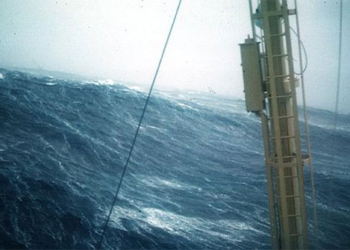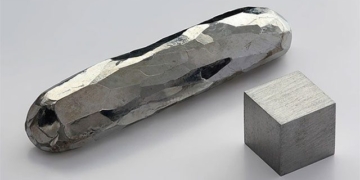Many of us might think that orcas have no eyes or that their eyes are the white patches on their heads. However, their eyes are actually quite small and located beneath the white spots at the front. These eyes are very small and completely disproportionate to the massive size of their body and head.
So why are orca eyes so small? What is the function of the large white patches on their heads?
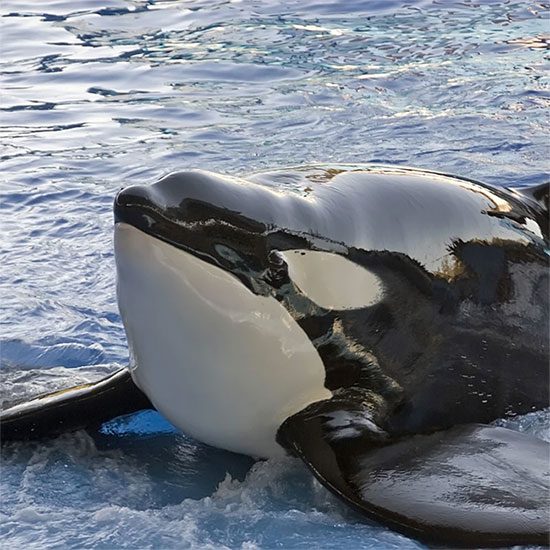
The orca, also known as the black dolphin or killer whale, is a species of dolphin belonging to the suborder of toothed whales, related to oceanic dolphins. This is the largest species of whale in the family. Additionally, they are very adept at intimidating other creatures, even daring to bully the great white shark, considered the ocean’s apex predator.
Why Do Orcas Have Such Small Eyes?
In fact, not just orcas, but almost all whale species have small eyes that are disproportionate to their heads and bodies. For example, the blue whale, the largest animal ever to exist on the planet, has eyes so small they are nearly invisible compared to its massive body size.
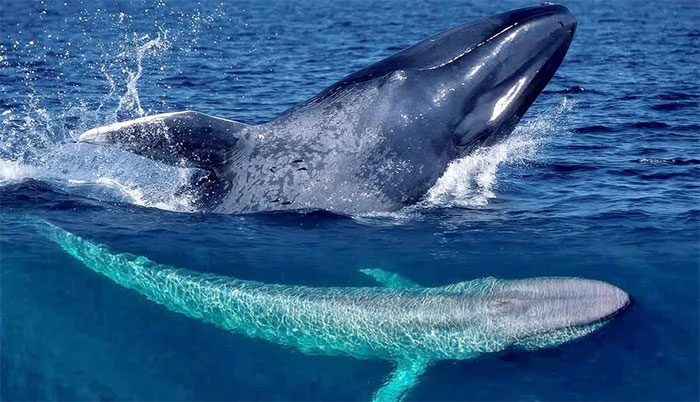
The blue whale, also known as the blue giant, is a species of whale belonging to the suborder Mysticeti. Measuring 33.5 meters in length and weighing 200 tons or more, it is the largest and heaviest animal to ever exist. The blue whale has a long, slender body, which can be a bluish-gray color on the back and lighter on the belly.
The earliest ancestors of marine mammals, the ancient Pakicetus whales, began to evolve around 50 million years ago. About 35 million years ago, primitive marine mammals developed eyes that could possibly have strong underwater visibility.
According to scientific research on whale eyes, a type of protein called “rhodopsin” has been discovered, which enhances the whales’ ability to capture light underwater and helps them hunt for prey in the depths of the ocean. Clearly, with such strong underwater vision, whales would need to evolve to have larger eyes to develop this potential.
However, the eyes of whale species are very small, and this is related to the environment in which they live. Strong visual capability for survival underwater is important, but having large eyes under water can also have a deadly drawback. Light scatters and refracts in water, which also contains many different impurities, and the visual distance of aquatic animals is very short, which is not beneficial for large animals like whales in their hunting.
Additionally, most whale species live in groups and have significant communication needs, so they require an organ not only to locate prey from a distance but also to communicate with each other. Therefore, they have developed an echolocation system, allowing them to “see” further away and detect more surrounding objects without the need for their eyes, while also enabling communication with their peers through this system.

Baleen whales have developed the ability to echolocate using low-frequency sounds, while toothed whales have developed high-frequency sound echolocation abilities, and these capabilities have been reinforced through the process of evolution. However, toothed whales typically rely on their foreheads to capture sounds while baleen whales depend on their ears.
With such an “advantageous” system, the eyes of whales will evidently be less functional. Even if they continue to evolve, the eyes of whales remain limited by their environment, so compared to other organs, their eyes have not evolved significantly over time. The small size of whale eyes reflects their evolution of other organs to compensate for the limitations of their eyes in the aquatic environment.
The Mystery of the White Patches Above Orcas’ Eyes
Orcas have small eyes, but adjacent to their eyes are large white patches, making it seem from a distance that these two white spots resemble their eyes. So what is the function of these eye patches?
Some scientists believe that the white patches on orca eyes actually serve to protect their eyes. Although orca eyes are not as crucial as their echolocation system, they are still important.
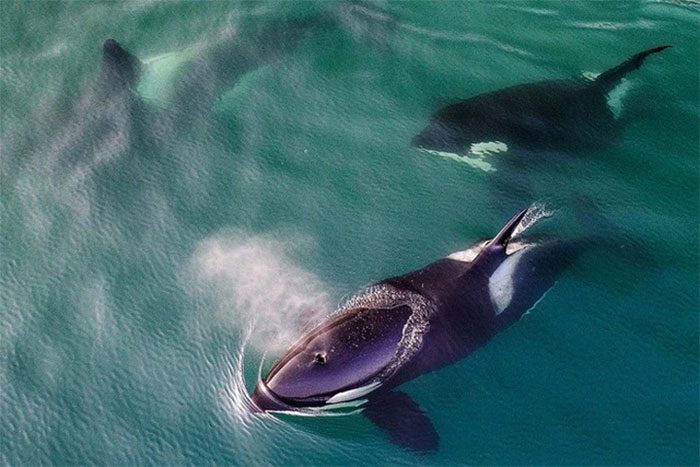
Despite their cute appearance, they are not a gentle species; moreover, they are considered the ocean’s apex predator.
As carnivores, orcas hunt and kill many marine creatures, including seals, sea lions, and other more agile animals that could potentially harm the orca’s eyes. Therefore, these large eye patches might confuse other animals and prevent them from attacking the actual eyes.
This hypothesis seems reasonable but is not entirely correct. First, orcas are a marine mammal species with a very wide distribution. According to current scientific classification, orcas can be divided into four types (A, B, C, D). These four types of orcas generally have similar shapes but show significant differences in their eye patches.
Second, the prey preferences of these four types of orcas also vary greatly, and furthermore, biologists have observed that orcas have very few scars around their eye patches because the prey attacked by orcas is usually torn apart quickly, leaving no opportunity to attack the orca’s head and eyes.
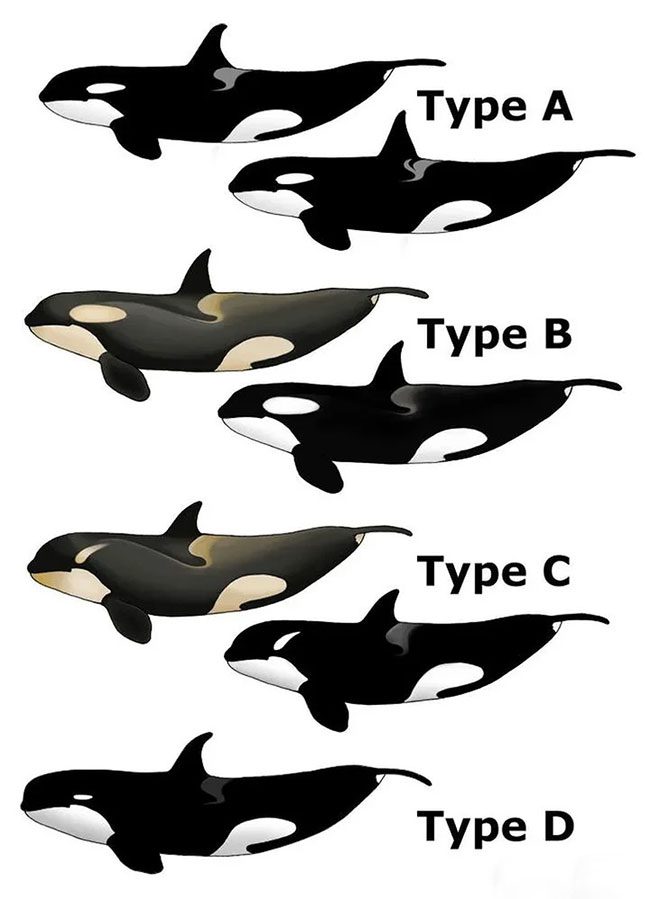
This species also possesses a very high IQ and can outperform many species on our planet. After all, orcas are certainly not simple creatures.
What is the Purpose of the Large Eye Patches on Orcas?
Since this is a common characteristic of all orca species, it must serve some essential function for their survival. From the ecological niche of this animal, biologists speculate that the eye patches may relate to their hunting activities.
Overall, orcas have black backs and white bellies, which is a color scheme that can camouflage well in the aquatic environment. For instance, when orcas swim above, animals below can see their white belly blending with the white of the sea surface, allowing orcas to hide better and thereby increase their success rate when approaching prey.
When orcas swim in the middle or deep in the ocean, marine creatures above see the orca’s black back, which nearly blends into the deep-sea environment with its dim light.
The large white patches above their eyes have a similar effect; when looking at one side of the orca, as the orca approaches its prey at the same depth, its body becomes more mottled in the prey’s vision, making it difficult for the prey to judge the size of the orca (most marine creatures can only see in black and white).








































